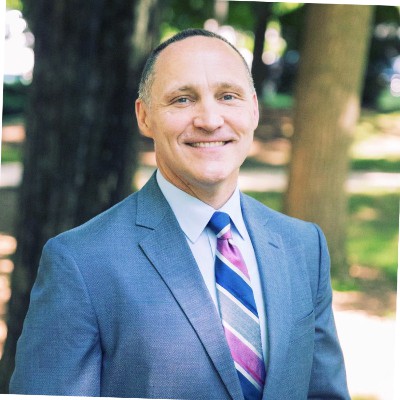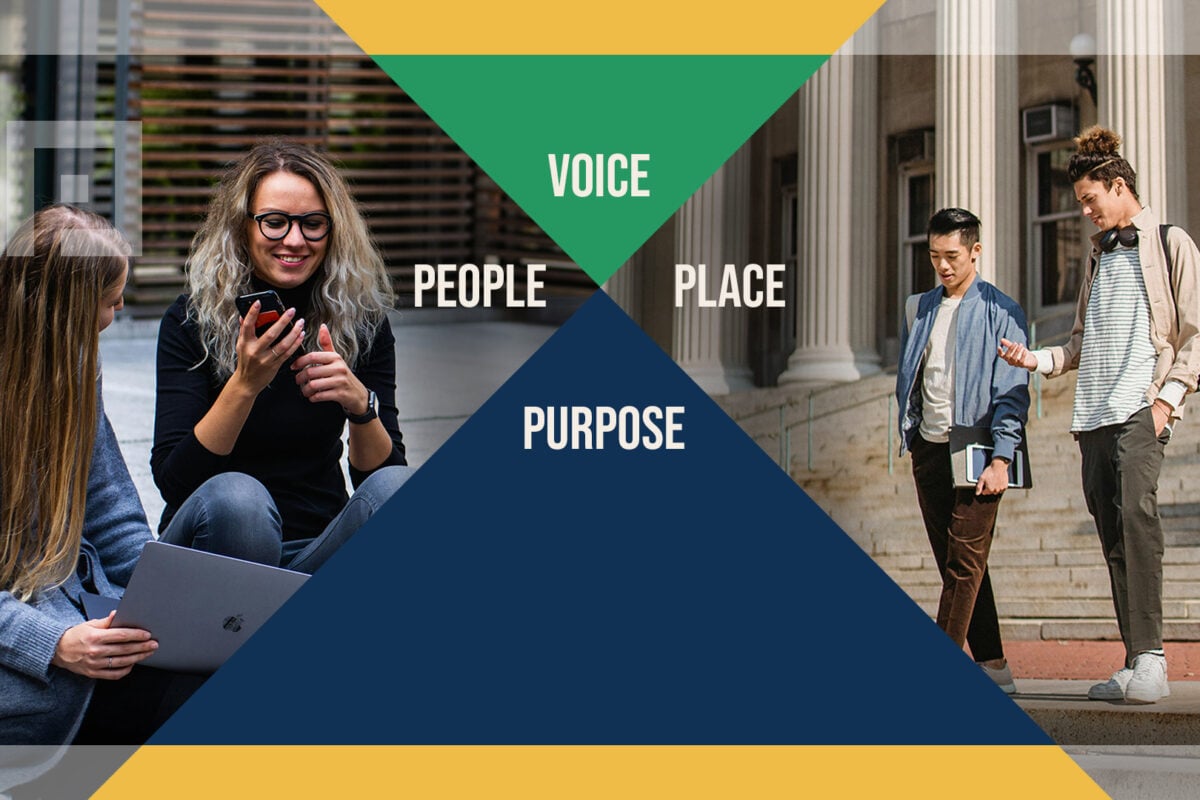Changes in FAFSA have proved challenging this year, especially for institutions where decisions to enroll hinge significantly on cost. In this episode, the evolving landscape of FAFSA is explored, including its recent changes, and the challenges it poses for families and institutions.
Show Notes
Dr. John Chopka from Messiah University and marketing strategist Michele Loeper explore the complexities of financial aid, the importance of effective communication and strategies for highlighting the value of higher education.
This episode addresses:
- FAFSA Changes and Challenges: Recent changes to the FAFSA system, including the removal of the sibling discount and new calculations for family contributions, have created significant challenges for both families and institutions.
- Institutional Strategies for Supporting Families: Dr. John Chopka discusses how Messiah University’s admissions team has adapted to support families through the FAFSA process, emphasizing the importance of clear communication and providing well-informed financial estimates.
- Parent Perspective on Financial Aid: Michele Loeper shares her personal experience as a parent navigating the college application and financial aid process, highlighting the anxiety and complexity involved.
- Communicating Value Proposition: The importance of clearly communicating the value and return on investment of a college degree to prospective students and their families, particularly in light of increasing skepticism about the cost of higher education.
- Improving Communication and Support: Strategies for higher education institutions to simplify financial aid communications, improve support for families and gather feedback to continuously enhance the enrollment process.
Transcript
Cathy Donovan:
Hello and welcome to the Innovating Enrollment Success podcast, where we talk about what’s happening in higher education marketing so that we can all be better connected and hopefully create better outcomes. I’m Cathy Donovan, agency marketing director at Paskill, a higher education enrollment marketing firm where we are always looking to deliver a positive higher education experience for students.
Positive higher education experience and FAFSA may not be words heard together right now. It’s been a year of change for FAFSA and a good time to talk about what we’ve learned so far and what’s still needed to improve the process for families and institutions. According to some sources, as of May 24th, about 14 percent fewer high school seniors had completed a FAFSA than at the same time last year.
That translates into almost 300,000 fewer high school graduates completing the form. In addition to the issues with the updated system, there are other significant FAFSA changes. FAFSA no longer includes a sibling discount. There’s a new calculation for how much upper- and middle-income families can afford to pay and more lower- and middle-income families are eligible for Pell Grants.
It’s a complex topic, but one we’re going to explore today with two brave guests coming at the issue from different vantage points. First, I’d like to welcome Dr. John Chopka. As vice president for enrollment management at Messiah University, John oversees the offices of admissions, financial aid and volunteer and church relations.
These offices are responsible for recruiting prospective students and working with strategic influencers. His team works closely with colleagues from across campus to ensure excellence in service. John has been a force in higher education for 30 years. Welcome, John.
Dr. John Chopka:
Hey, thank you, Cathy. I really appreciate the opportunity to discuss this.
I will tell you from the onset here, this has been one of the biggest stressors in 34 years of enrollment. And that’s saying a lot because we just came through a pandemic. And I think COVID definitely brought a special kind of stress, but I feel like we all improvised then, right? As a way to serve students well at our respective institutions.
In a sick way, it was energizing to figure out how we were going to adapt to meet our goals in the midst of a pandemic. And out of that came the word pivot. We changed things. We sped up processes. We took meetings and courses online. And we felt like we could be creative to meet students’ needs. Well, it’s been hard to pivot into FAFSA changes, but I’ll be happy to share how we’ve attempted to manage it all.
So thank you for including me in this conversation.
Cathy Donovan:
Fantastic. We’ll also be joined by Michele Loeper. Michele oversees JPL’s specialty practice dedicated to accelerating the growth and organizational performance of healthcare brands. A highly skilled marketer and strategist, Michele is also a mother, one who not too long ago endured the college application process.
Her insights will be instructive. Welcome, Michele.
Michele Loeper:
Thank you. So great to be here with both of you today. Thank you so much for the opportunity. Yes, I am a recent mom of a college student. She’s now successfully enrolled in college and wrapping up her second year. But I very much remember the journey of embarking on searching for a college, applying to a college and then, of course, trying to navigate the complexities of FAFSA.
So happy to be here today to lend my thoughts and experience as a mother, but also some more instructive and professional guidance and point of view from a strategist perspective.
Cathy Donovan:
Wonderful. Welcome. So let’s get started. So John, let’s talk about the financial aid system.
According to a recent New York Times article, of course, there’s many, but this quote sums up a lot of the issue, “The complexity comes from countless numbers of well-meaning people inside government and out who have made incremental improvements over decades to increase access to higher education, making it more affordable for more people.
“But,” the article adds, “as income inequality increases and college costs rise, each new collection of freshmen requires ever more help, more counselors, programs, regulations, and relief leading almost inevitably to conflicting advice, new rules, strange loopholes.”
John, how accurate is that from your point of view? And please give us your broad overview of financial aid, its intended purpose, and its current status.
Dr. John Chopka:
Yeah, definitely. I concur with what you just read there. Simply stated, financial aid exists to increase accessibility to higher education. And I think the FAFSA has been the primary form for accessing federal funds and for demonstrating need for additional forms of aid for a very long time.
In fact, it stems back to the Johnson administration and the Higher Education Act of 1965. That made the federal government a big source of financial aid for students. And the form itself has evolved over decades. It became the common financial aid form in the 1980s, and that’s when I filed it way back in the Stone Ages.
It ultimately became the Free Application for Federal Student Aid as part of the Higher Ed Reauthorization Act of 1992. And I think financial aid regulations have really ramped up in recent decades, but the form really just experienced minor adjustments until the FAFSA Simplification Act was passed by Congress back in 2021.
So it wasn’t like this crept up on us. It was adopted in 2021 and it’s in effect for the first time for this fall’s students, the 2024-25 school year. So everyone agrees the implementation for FAFSA has been disastrous, but to one of the points in your questions, I do believe the intent was noble.
The form has long been way too complex and Congress wrestled with how to simplify it for years, even decades. But as the very term “FAFSA simplification” denotes, it was indeed intended to make it easier to fill out the actual form. And it appears they met that goal. They reduced the number of questions from well over 100 to about 36 questions.
So that’s a big improvement. And they are importing much of the required data from the federal tax database to reduce what must be entered manually now. So if all of that works well, goal one is accomplished. But another goal was to see that more families qualify for federal Pell Grants. And that even more received the maximum award of $7,395.
That’s what they’ve locked in even for this year for the Pell Grant. And I think that’s ultimately been accomplished with more – they’re projecting anyway – more than a half million new families will become eligible under this new methodology. But for us, what we’re asking is how many students have been delayed to the point of discouragement this year?
I think admissions offices across the country are still sorting through how this will impact overall enrollment for this fall.
Cathy Donovan:
It’s troubling, but at least there are good people like you and your team that are working with families. You know, John, just a quick follow up. While this system is complex and it’s really unusual for this point for these families, how do teams like yours stay with families and make sure that you don’t lose them?
Dr. John Chopka:
Yeah, that really for us has fallen on the Admissions Office at Messiah. We did a really good thing several years ago. We cross-trained our admissions counselors. And so, yeah, a lot of offices or a lot of institutions, you call into the financial aid office, and there are a limited number of folks that can really help sort through what your questions may be. But at Messiah, our admissions team is the front line. And for us, that freed up our financial aid team to invest in the packaging, the formulas, the technology that was really going to get packages out to families.
And because we were so delayed, and we’re talking months, right? We usually send packages out in January and that didn’t happen until April of this year. We invested a lot of time giving estimates, but they were pretty well-informed estimates. We secured what we could from the federal government on their methodology, and then we worked individually with families to talk them through what they would likely qualify for once we secured the FAFSA data.
And I will tell you, families were gracious. As frustrated as we were, families really kind of understood this isn’t on the institution – we’re all in this together – and I just appreciate their patience with us as we got packages out late this year.
Cathy Donovan:
That makes sense. It seems like, like we said with COVID where you could pivot, here it’s harder to. But it seems like where you did was by continuing to nurture those relationships the best that you can.
So, Michele, your experience was before FAFSA, but it was still complex then, right? So, if you could just talk a little bit about, you know, just to hear your parent’s point of view about the college application process in terms of financial aid and, you know, just to give us that kind of emotional state of a parent going through this process. You want to do the best for your child, right, to get them to a good school and do everything right, but it could be very daunting. So I just want to hear a little bit from you – a glimpse into that experience.
Michele Loeper:
I’m absolutely happy to share my experience. Look, as a parent, it’s such a wonderfully exciting time in your child’s life.
It’s something you’ve been looking forward to, planning for, hoping for, for a very long time. But I have to say when the time came to embark on the journey of applying for colleges, figuring out how to pay for it, I kind of felt like a fish out of water. There was a lot of anxiety, anxiety around thoughts of can we really afford this? How much is this really going to cost?
And one of the things that became obvious to me as a parent going through this journey – it had been a few decades since I was in college, so things had changed a bit – but as I was sitting in the parent seat now embarking on this journey and trying to understand what the costs were going to actually be… That’s when I realized this was somewhat analogous to, in my mind, analogous to purchasing a car.
You know? It’s like, there’s the sticker price of the car, but we all know that’s not what we pay, right? Like we get in there and then we negotiate, and we talk about financing and they ask you questions about how much you want to pay every month and then, do you have a trade-in and, do you have a down payment. And there’s all these factors and then they go back in their mysterious room and have conversations and come out and then there’s a price and then there’s still room to negotiate.
And I kind of felt like embarking on this journey of understanding financial aid and grants and getting to just understand how much debt I will incur, how much debt my daughter will incur. That was not easy to figure out. It was really complex.
And that’s where a lot of the anxiety, I think, comes in for parents. It just feels like it’s really hard to gain that understanding. The FAFSA process itself was cumbersome. And that definitely put fuel to the fire for my anxiety. I’ll just say this, I made a misstep right away in the FAFSA process.
Although I didn’t realize it until much later down the line, and it had to do with the creation of my FAFSA ID and verification process. My daughter had created an ID a couple of months prior, and so it just kind of made things really complex when it came time to having things sync up, having my tax information incorporated. It was a bit of a mess.
And it was scary and anxious because the consequences seemed really high. You know, I didn’t want to make a mistake that was going to impact the cost of my daughter’s education. And so embarking on this journey, even though I felt like I was embarking on it alone, and even though there’s a ton of information out there, right? There’s resources, there’s videos, but it’s really complex.
And here’s an example of something that really speaks to the complexity of the FAFSA journey. For example, the financial aid section on the website of the school my daughter attends lists 13 different videos to help you learn about applying for aid. It takes 13 different videos to help you understand this process. And that alone, just landing on that page, it felt like, “Oh my gosh. I wish there was an easier way. This feels like a lot coming at me at a time when I’m already feeling crunched with a deadline, overwhelmed, anxious.”
It was a lot to sort through. We eventually got there. We eventually got through it. All’s well that ends well, but not without a lot of pain and a lot of frustration and a lot of worry.
Cathy Donovan:
Well, I’m so glad you made it through and that your daughter had you to stay in it for her. John, you’re on the front lines and you know how important every dollar is to families. Does Michele’s story sound familiar? What kind of insights can you offer to kind of confirm her experience and maybe how Messiah helps folks like her find their way?
Dr. John Chopka:
Yeah, unfortunately, Michele’s story sounds all too familiar. And I think it’s going to resonate with many who found themselves in the waiting game this year. I think it’s important to remember that in addition to stewarding millions in federal and state financial aid, most institutions – most colleges – also manage their own financial aid coffers. Yes, we’re bound by the federal methodology when it comes to awarding things like Pell Grants and what percentage of a student’s loan is subsidized versus unsubsidized, but what we did to try to minimize some of the pain is make it very clear regarding other types of aid.
We know some of the changes related to how FAFSA views families with more than one in college, or what it means for the family farmer or small business owner, we know all that’s caused some stress with families this year. So what we’re doing, we’re trying to keep families whole in spite of how the new student aid index compares to the former EFC or the estimated family contribution.
So that took a lot of special dispensation, if you will, for how we package our own financial aid, and I think our families will be pretty pleased if they have two coming or two in college that we are looking at that, even though one of the changes this year really kind of hits families hard to have more than one in college.
And then as I referenced, even before the official financial aid offers went out in late April, we did our best to get solid estimates into the hands of our students. And in many cases, that was enough to encourage a family to deposit. But for others, it wasn’t. They said, “Well, we just want to wait.”
And most of us moved our deposit deadlines to May 15 or June 1. We moved ours to June 1, and that gave families a little bit of time, but it just, again, I think it contributed to the anxiety somewhat, too. I had one mom who came to an accepted student event, and this is back in April. Typically, families come and they commit with a deposit before they leave. And this mom remembered me from a fall event. And she said, “John, we almost deposited.” And I said, “Well, what’s holding you back?” And she took me aside and said, “I just don’t want Jenny to get her hopes up. And so we don’t want to make a lot of emotional decisions, so we’re going to wait until we have the official award. As long as that June 1 timeline is still legitimate, we’re going to wait.”
And so we, we found kind of a rush of deposits coming in prior to June 1, just as if it were May in other years. So, yeah, I understand that. I understand the family’s objections to making a commitment before they know for sure. But I think it was really incumbent on institutions to do what they could with their own institutional aid to make sure that was very clear.
Cathy Donovan:
Right. So it sounds like it’s important for individual institutions to do their work and what they can do to provide offers to families, but it seems like communication is a big part of that.
You know, Michele, as part of switching gears from being a mom to being a communicator and a marketer, I’d love to get your insights on, are there any recommendations you would give to institutions about how you approach communicating such a complex topic to let parents know that you care and to give them the information they need in as timely a way as possible.”
Michele Loeper:
Yeah, gosh, Cathy, I’ve been thinking about this a lot since I’ve been on the journey. And the one thing that I keep coming back to, when I think about the decision that parents and students together make around which school am I going to commit to? Which school am I going to apply to? Can I afford this?
To me, that decision-making process comes down to one very important thing: Value. Value is the opportunity that colleges and universities have to begin to really connect with parents. Look, we can’t change FAFSA. We can’t change that process, unfortunately. You know there’s very little we can do there. It is what it is.
And it is necessary. And it, in and of itself, is necessary and provides value. But colleges and universities, what you can do is hone in on your own value and help parents and students understand the value of a degree from your institution. And the reason I say that – it really all comes down to value – and why I place such emphasis on this is, there are a lot of factors right now that are playing into this.
One, you know, just recently there was a report that Forbes did an article on that showcased nearly 70 percent of parents would now support their child entering the workforce immediately upon high school graduation. That is up significantly from just a few years ago.
College has traditionally been considered the route to economic security, right, via the best-paying jobs. But with the high cost of earning a four-year degree these days, the return on investment of paying for that degree is not always clear to parents. In that same study, it also showed that less than half of parents thought that taking out student loans to pay for college is worth the burden of debt their children will be forced to pay off.
So look, there’s been a ton written about this, right? We understand that this is a sentiment that is paramount right now with parents and students alike. But given that, there is still an opportunity for universities and colleges to really focus on their value proposition and helping parents understand the return on investment.
What does it mean to get to earn a degree from your university? How will students benefit from that? I mean, look, this is a considered purchase. There are few things in life we buy that cost six figures, right? So it’s quite reasonable for students and families to ask why they should get a degree and how it will benefit them.
These are questions we’re going to hear more and more. The research shows that. So the value of the university’s degree, it shouldn’t be a mystery to students and their families. As a marketer and as a parent of a college student, I can say that colleges and universities have some work to do when it comes to explaining the ROI and the value of this very significant investment.
There was a time when the value of a four-year degree was generally understood. You’re better off if you go to college. We know that data shows that that is still very much the case, but the consumer doesn’t necessarily understand that.
So, begin by asking parents and students for honest input about their experiences, their perceptions, and their expectations about things like the application journey, the financial journey, the journey of simply finding the schools and helping their child select a school. Research with parents and with students is one way to really hone in on what’s important to them. So that’s a big piece of it as well.
So I would say really refine your value proposition so that it speaks to the needs and concerns of parents, help them understand the value of the education, not in general terms, but specifically as it relates to a degree from your university. I think that can go a long way in terms of easing their anxiety, because that is certainly part of it. They know that their child will be taking on debt and incurring debt when they graduate. So naturally they’re going to feel a little bit better, and so is the student, if they understand the value of the degree and what they can count on as a result of earning it.
Cathy Donovan:
John, I’m sure you have some answers here because this is probably what Messiah does every day: Communicating the value of why Messiah. And I know for myself, talking for an agency, the higher ed experience is the ROI, but there’s so many intangibles that I think become part of that value proposition as well. So John just wanted to open it up to you, if you have any responses to what Michele has shared.
Dr. John Chopka:
Oh man, I loved it. It was like being in a class for an admissions counselor. We preach “value proposition” probably every day here. Families, more than ever, really need to be convinced that it’s worth the investment because it is indeed an investment And we’ve tried to make the case through a lot of data about things that you would expect a family to ask about: jobs, placement into grad school and med school, average earnings.
But I encourage families to ask about things like loan default rates. And if they’re taking out loans, are they able to pay off their loans?
I think with this FAFSA debacle, schools that are strong are going to weather it okay. But there are going to be schools out there that don’t have the strong value proposition. They haven’t made the case for an investment in their institutions. We’re going to see more closures. That used to be the threat, even over the last decade, that colleges are going to close, but we’re actually experiencing it now to the tune of about one a week now in the U.S. It’s very sad.
And part of it is the value proposition. So we publish a lot of data to show families. But we also remind families that in addition to helping their students earn a living by coming to college, we help them build a life. It’s the enrichment. It’s the opportunities to learn about the world. And being a faith-based institution is also a spiritual component for us, you know, that it’s about a life and an abundant life.
So, yeah. Amen sister appreciated that a lot.
Michele Loper:
One thing, if I can, Cathy, just jump in really quickly to add to that is that, gosh, I mean, as I said, we can’t improve the FAFSA process. It is what it is. But in my own journey as a parent on the university site where my daughter goes to. When I stumbled upon – not stumbled upon – went looking for the financial aid section and stumbled upon 13 videos that were designed to help me understand this process, it was like, “Wow, this is not helpful. This is not helping me.” And this is a major state university. I’m sure that they mean well, and they think that they’re being super helpful, but it was the opposite of that for me. It fed my anxiety. And so I think that there is an opportunity for colleges and universities to think about the ways that they can be a partner with their audiences in this process.
Are there tools that you can offer that really simplify this? Are you doing enough to simplify this process for them? How can you differentiate as a school in this piece of the journey, which is a really critical part in that entire decision-making journey on higher education. So I think one of the best ways to understand where you can be an advocate and where you can be a partner is by asking and while the journey is fresh.
So maybe with these students who have just submitted their deposit, maybe you could send a survey to these parents and ask specific questions about the journey to understand where their pain points specifically were and to identify opportunities to be able to improve your communications.
Cathy Donovan:
John, any thoughts on future trends of talking to parents, or like Michele is suggesting, really listening to their pain points and trying to come up with some solutions? Because it does seem like costs will only go up. There will be more challenges, so it is an opportunity. But there does need to be a plan of what’s the next step for colleges and universities to speak a little bit more compassionately to parents about this.
Dr. John Chopka
Yeah, well, I’ll tell you, there are so many different sides to financial aid. There’s the regulatory side. And I think institutions can over-communicate to kind of cover themselves, right? To say, “Well, we, we’ve defined all these terms,” and then you overwhelm the family by putting out 13 videos on defining terms and how to file for financial aid. So you know, FAFSA simplification, if you will, also applies to colleges and universities. For example, on our financial aid website, we have seven steps for applying and receiving financial aid. It’s a seven-step process. Now, one of the biggies is filing that FAFSA. And we know that it’s been a stressful year with that, but yeah, definitely, I like some of the suggestions you’re making there.
And then we also do need to hear from families. We conduct what we call “admitted student research.” And so whether a student chose Messiah or not, we want to know what did they think about our processes for admissions, our campus visit programs, and how we presented financial aid. So we take that advice to make improvements year after year, and I think, strong institutions will be wise to do that.
Michele Loeper:
That’s great.
Cathy Donovan:
Any last thoughts about our conversation today?
Dr. John Chopka:
Well, it’s been a stressful year, and I think that’s made me kind of skeptical about the future of FAFSA and the government’s ability to handle implementation. But I will say just last week, Secretary Cardona promised a full-scale review. And he promised vast improvements moving forward. And I have to say, I need to hold out hope lest I become jaded by what happened this year. And I’ll join Michele in encouraging colleges and universities to be transparent and creative in how we serve our students. And it may feel like overkill, but we need to invest in our resources, our website, cost calculators – everything we can do to keep families informed.
Cathy Donovan:
Fantastic. Well, thank you so much for joining me today and helping us all take a deeper dive into the state of financial aid in 2024. To learn more about John and Michele, please see our show notes or find them on social. Thank you so much for joining me today and talking about this complex issue, but giving us all a little bit of hope that there are ways to do it better within the resources that we have. So thank you.
Dr. John Chopka:
Yeah. Thank you, Cathy.
Michele Loeper:
Thank you so much.






